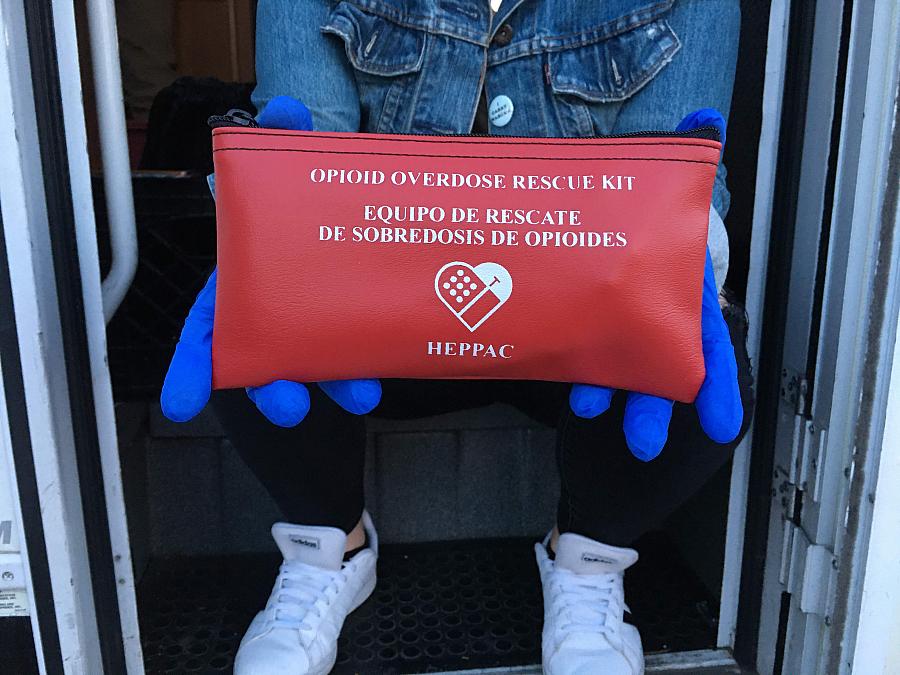While the pandemic raged, overdose deaths spiked in the Bay Area

Michaella Jones of the HIV Education and Prevention Project of Alameda County holds up a Narcan overdose reversal kit in April 2020.
(Photo by Ariel Boone)
Michaella Jones is wearing a cloth mask and sterile gloves, sitting at the open side door of an RV, ready for her next visitor. “It got cold!” she says. It’s sunset in Oakland’s Fruitvale neighborhood, and a line of people stretches from the RV into the parking lot of a nearby auto repair business, waiting for clean syringes and health consultations.
Jones is the coordinator for overdose prevention, education and naloxone distribution with the HIV Education and Prevention Project of Alameda County, or HEPPAC. It’s one in a small group of harm reduction programs in Alameda County. And her team of colleagues and volunteers is delivering clean needles, pipes, water and snacks, overdose reversal medication, safety consultations and natural health remedies in brown paper bags to anyone who wants them.
Early in the pandemic, some East Bay street outreach programs ground to a halt. Bathrooms normally open to unsheltered people were shuttered. Libraries closed, cutting community members off from the internet and a place to charge phones. Volunteers and staff could no longer gather in close quarters, and for a while, some free outreach programs providing food or hygiene help dwindled off completely. But harm reduction advocates doubled their efforts, faced with soaring demand for syringes and the overdose reversal medication naloxone, known as Narcan.
These community workers feared the worst: That more people would be using untested drugs, more often, potentially alone for fear of contracting COVID-19, and that this would result in a surge of overdoses and deaths. The data now shows that this has happened.
As the COVID-19 pandemic raged, the U.S. saw an astronomic increase in deaths from drug overdoses. For the twelve months ending in August 2020, the CDC recorded over 85,000 deaths from opioid overdoses, seemingly the highest number in U.S. history. In California, nearly 8,000 people died in that time frame. In Alameda County, this crisis is inseparable from race and class lines — Black residents in the county experience rates of death from opioids nearly three times the death rate of whites, and are more likely to be unhoused. Preliminary county numbers show the death rates from prescription opioids and synthetic opioids like fentanyl may have doubled in the first six months of the pandemic.
In early 2020, the DEA loosened restrictions on medical providers prescribing medication treatment to opioid users telephonically. Some counties also lifted restrictions on syringe distribution, loosening requirements that for every syringe an organization distributes, they must collect one. HEPPAC’s Executive Director Braunz Courtney said this change was welcome in Contra Costa County — it meant harm reduction organizations could give out more supplies at a time, and community members didn't need to leave their homes as often, potentially exposing themselves to COVID.
In one week of April 2020, the harm reduction volunteer group West Oakland Punks With Lunch gave out over 16,000 syringes in one week, almost double pre-pandemic times. At the same time, the organization heard from community members that there was a huge uptick in Narcan being used to reverse overdoses — they counted 20 in one week.
Still, the crisis and deaths have worsened, even while health workers, federal health agencies and community-based mutual aid groups have intensified efforts to reduce the likelihood of overdose.
“Trauma and drug use are linked together,” says Savannah O’Neill of the National Harm Reduction Coalition, on why drug use has increased during the pandemic. “Isolation, job loss, loss related to death — all can trigger drug use, deeper drug use or relapse. All of us rely on routines to keep ourselves stable.”
Social isolation contributes to overdoses by causing people to use drugs alone, where no one else is able to administer Narcan. Disruption in drug supply chains can cause people to use untested or unreliable substances, including drugs that users may not know contain fentanyl. Furthermore, Alameda County health workers attest that people using drugs have delayed seeking medical care because of fear of contracting COVID-19 in emergency rooms, including for potentially life-threatening issues like abscesses.
Harm reduction is one part of a collage of services needed in Alameda County, especially Oakland, where an estimated 4,000 people are unhoused.
There is great urgency for reporting on the opioid crisis and its deadly trajectory during the pandemic in the Bay Area, and for airing and printing the words of people most affected. Through radio and print stories, this project for the 2021 California Fellowship will examine the crisis in the East Bay, primarily in Alameda County, featuring the voices of unhoused people who have faced overdose risk during the pandemic.

